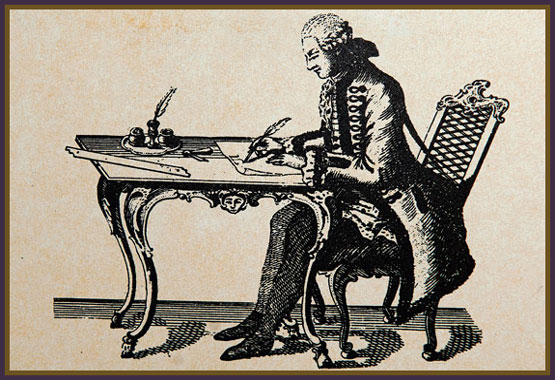
Orfelin became the secretary to Metropolitan Pavle Nenadović in Sremski Karlovci, the Serbian political and spiritual centre at the time. Metropolitan Pavle wanted to establish Karlovci as an independent educational centre and evade Imperial Austrian control over censorship. In collaboration with Zaharije Orfelin, he founded the "Copper Publishing House", where the first modern Orthodox literary works and a considerable number of prints were made. Soon Orfelin began publishing poems, translating books, and creating etchings and engravings, inspired by the work of his contemporaries. To fulfill his ambition to print more books, he moved to Venice where he founded and edited the first Serbian review, Slaveno-Serbski Magazin (1768). Poem Plač Serbii. The Lament of Serbia] and biography of Peter I of Russia Istorija o žitija i slavnih djelah velikago gosudarja i imperatora Petra Pervago are considered his most notable works. His Slaveno-Serbski Magazin paved the way to the Slavonic-Serbian language. He was the first to publish in the 18th century texts pertaining to Serbian social and cultural history when other European nations had yet to entertain the subjects. During this period Orfelin first began to write The Big Serbian Herbalium, in which he detailed the sanative effects of 500 species of herbs. And, in the Experienced Winemaker he listed several hundreds of recipes for preparation of herbal wines and other potions. Orfelin was fluent in Russian, Latin, German, and French.
Saint Lazar, Serbian Great Prince, a copperplate by Orfelin (1773).
The Lament of Serbia is regarded as the most notable among his poetic works of that period. He first published it anonymously in Venice in 1761. In this ode he fiercely pilloried the establishment of the Austrian Empire and the Roman Catholic Church, while also emphasizing the difficult position and unjust treatment of the Serbs under the Imperial protection. Even though the poem bore no signature, the authorship was soon discovered. It is believed that this was a reason for his hurried exit from Karlovci the following year.
After leaving Metropolitan Pavle, Orfelin moved to Timisoara, the capital of the Eparchy of Banat, where he secured employment as the chancellor of the Serbian Bishop of Banat, Vikentije Jovanović Vidak. In the years he spent in Timisoara he produced The Apostolic Milk, a catechism dedicated to his infant son in 1763.
In 1764, Orfelin came to Dimitrios Theodosios's publishing house in Venice, where he spent the next six years before moving back to Karlovci. Theodosios, who began to print Serbian books in Venice in 1758, needed Orfelin to edit and proofread the abundant material being brought to him. Theodosios remained the only outlet for Serbian literature and printed books in Russo-Slavonic until the emergence of Kurtbek's publishing house in Vienna in 1770. Orfelin's editorial work gave a special impetus to the success of this Slavic publishing house. In a span of a few years many important books – "Catechisis" by Peter Mohyla and another "Catechisis" by Jovan Rajić, "Srbljak" (a compedium of old Serbian writings) and "Short Stories" by Feofan Prokopovich – were published there. Many of the books published were either translated or edited by Orfelin himself. He also published his own, original works, including "A Melody for the Spring" and "A Historical Poem" in 1765, "Latin Alphabet" in 1767, and "Latin Grammar" and "Slavic Alphabet" in 1768. A large number of the books printed in Theodosios's shop in Venice were purposefully mislabelled as printed in either Moscow or Sankt Petersburg publishing houses. The reasoning behind it was that Serbs under the Austrian rule had more faith in books published in Russia than in the West. While still in Venice, Orfelin also printed one of the most important copper engravings, St. George with the Image of the Monastery of Sendjuradj (1767), and the first one that he signed as a member of the Imperial Engraving Academy founded by Austrian Jacob Schmutzer.
